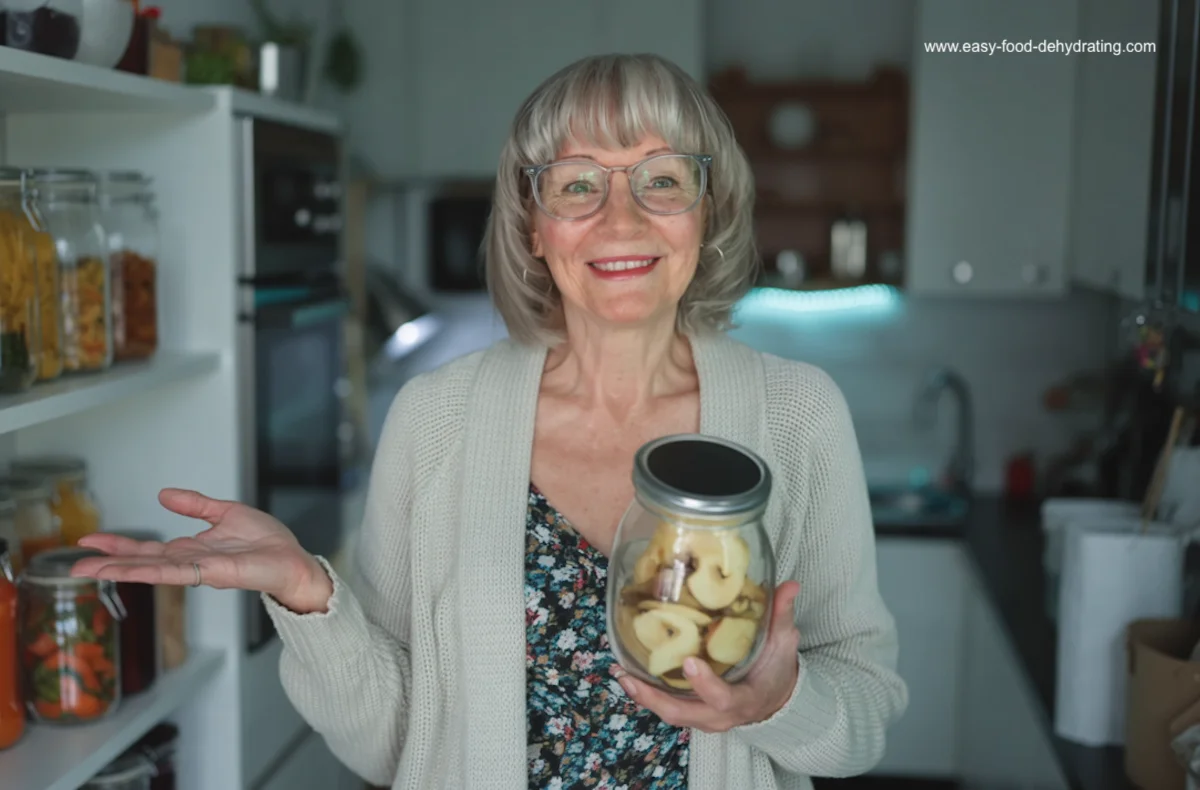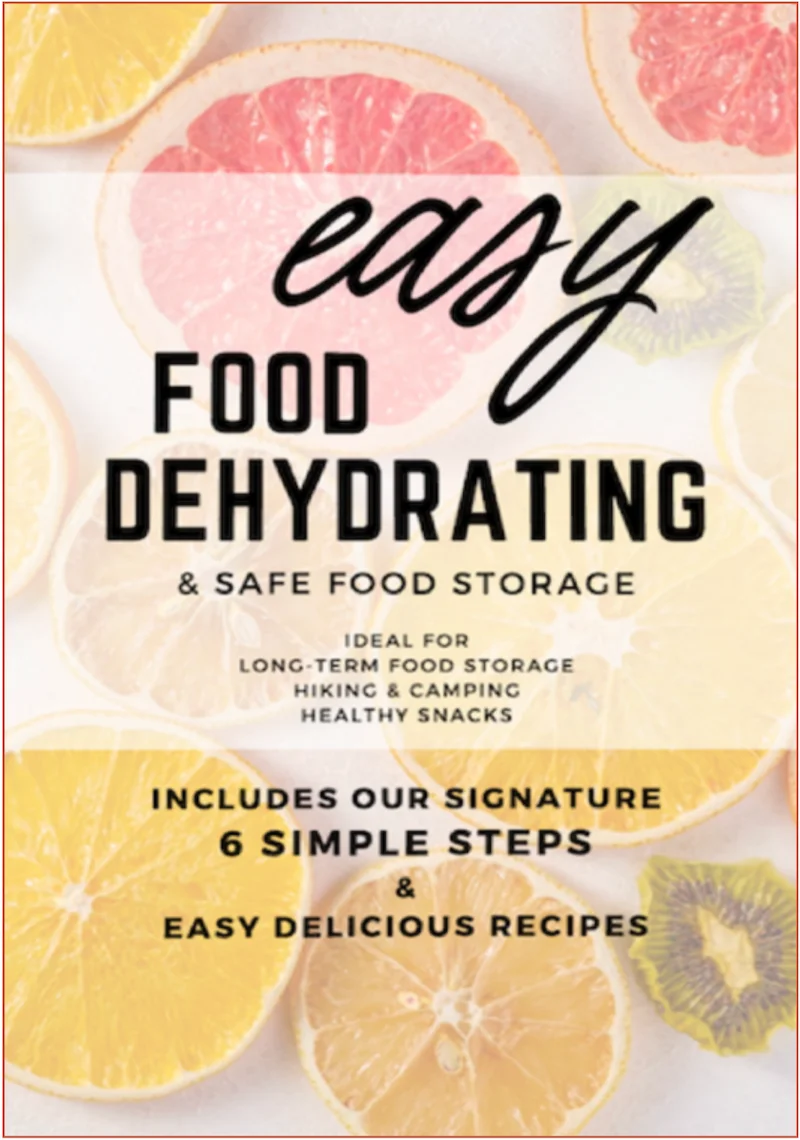What We Mean by “Dehydrate”
Here at Easy Food Dehydrating, “dehydrate” always means using an electric food dehydrator — the easy, reliable way to dry food at home.
- Home
- Why Dehydrate Food? 7 Important Reasons to Try Food Dehydration
Why Dehydrate Food?
7 Important Reasons to Try Food Dehydration

Dehydrating food isn’t just an old-fashioned trick — it’s one of the smartest ways to save money, cut waste, and create healthy meals that last for months. By removing moisture, you stop bacteria and mold in their tracks, keeping food shelf-stable and full of flavor without chemicals.
✅ Quick Answer: Why dehydrate food?
Dehydrating food makes it last longer by removing moisture that bacteria and mold need to grow. It reduces waste, saves money, preserves nutrients, and creates lightweight, healthy snacks — all without chemicals. Perfect for storage, emergencies, or everyday cooking.
Whether you want to stock up for emergencies, preserve a bumper garden harvest, or simply enjoy homemade snacks that beat store-bought options, food dehydration gives you control, convenience, and confidence in your kitchen.

Did you know that drying food is one of the oldest tricks in the book for keeping it fresh? It's super simple - just remove the moisture, and you've got food that lasts way longer!
Whether you're growing too many tomatoes in your backyard, looking to save some cash at the grocery store, or just want to be prepared for whatever life throws your way, food dehydration might be your new best friend.
Let's get going with seven reasons why you might want to give it a try!
1. All-Natural Preservation: Pure Food, Zero Chemicals
How Dehydration Blocks Bacteria and Mold
Worried about all those unpronounceable ingredients on food labels these days? Dehydration is about as natural as it gets! When you remove 80-95% of the water from foods, you're basically creating a no-entry zone for bacteria and mold. They need moisture to grow, and without it, they simply can't survive.
Real-life Shelf Life Examples
The best part? Your strawberry is still just a strawberry - minus the water! Your basil still has all those amazing essential oils and flavors without needing any chemical preservatives. It's just pure food, the way nature intended.
Why Natural Beats Chemical Preservatives
Properly dried apples and bananas can stay good for 5+ years! Veggies typically last about 8-10 months. All without a single chemical additive - just the natural goodness of the food itself, preserved by simply removing moisture.
2. Stop Food Waste: Turn Leftovers into Lasting Goodness
Garden Surplus Solutions
Ever feel guilty throwing away food? You're not alone! In America, we toss about 60 million tons of food each year - that's like throwing away 40 percent of the entire US food supply according to RTS.com's findings! Dehydration offers a super practical solution to this problem.
Saving Store-Bought Deals Before They Spoil
Picture this: you find an amazing deal on berries at the farmers market and buy a bunch. Two days later, some are already starting to get moldy. Instead of pitching them, you could dehydrate them and enjoy them for months! Or maybe your garden suddenly gives you 20 zucchinis at once (we've all been there!). By dehydrating the extras, you're saving all that goodness before it has a chance to go bad.
Transforming “Almost Bad” Produce into Usable Ingredients
Even those slightly soft strawberries, wilting spinach leaves, or super-ripe bananas that you'd normally toss can be transformed into nutritious ingredients for future meals.
3. Save Big: How Dehydrating Slashes Grocery Bills
Real-Life Cost Comparisons
Who doesn't love saving money? Dehydration lets you take advantage of sales and seasonal abundance in so many ways.
Seasonal Produce Savings Year-Round
When local farms are practically giving away strawberries in June, you can stock up and preserve that economic win all year round. If you're a gardener, the savings are even bigger. That tomato plant that cost you a few dollars but produced 20 pounds of fruit becomes an amazing investment when you can use and preserve every single tomato!
Here's a fun comparison: $2 worth of fresh apples can be turned into dried apple rings that would cost $8-10 in the store. Making your own beef jerky from sale-priced meat saves even more compared to those fancy $25-30 per pound packages at the checkout! See all my easy Jerky recipes here.
Family-Level Savings Over Time
A family that regularly dehydrates seasonal produce, takes advantage of meat sales, and preserves garden harvests could easily save $500-1,000 every year - while eating higher quality food than the store-bought preserved stuff.
4. Shrink It Down: How Dehydrating Saves Serious Space
Backpacking and Camping Space Savers
Dehydration does something amazing to food - it shrinks it! Most foods reduce to about one-third of their original size and weight when properly dried. This is super helpful in so many situations.
If you like hiking or camping, you know that every ounce matters in your backpack. A week's worth of dehydrated meals might weigh less than 5 pounds, compared to 15-20 pounds for regular food. Space-wise, a month's emergency food supply can fit in a small box instead of taking up a whole cabinet!
Small Kitchen and Pantry Solutions
Home storage becomes way easier too. A bushel of apples that would overflow your refrigerator drawer can fit in a single quart Mason jar when dried. This is perfect if you live in a smaller home or apartment where having cabinet space is like finding gold.
Emergency Food Supply Storage Benefits
Plus, when your food weighs less and takes up less space, you're using less fuel to transport it and fewer containers to store it. Your camping trip, emergency kit, and pantry just got a lot more efficient!
5. Packed with Nutrients: Why Drying Boosts Nutrition
Vitamins and Minerals Preserved
While some changes happen during dehydration, it's actually one of the best ways to keep all the nutritional goodness of your food intact. Unlike canning, which uses high heat that can destroy vitamins like C and B, proper dehydration (especially at lower temperatures) keeps most of the nutrients right where they belong.
Nutrients That Get Concentrated When Dried
Why dehydrate food? Dehydration actually concentrates certain nutrients! For example, 100 grams of fresh apricots give you about 12% of your daily vitamin A needs, while 100 grams of dried apricots provide nearly 50%! The same goes for all those beneficial plant compounds like polyphenols and carotenoids.
How Dehydration Compares to Canning and Freezing
Unlike many other shelf-stable foods that sacrifice nutrition for longevity, properly dehydrated foods give you the best of both worlds!
6. Busy Life Hack: Instant Meals with Dehydrated Foods
Ready-to-Eat Snacks with Zero Prep
Let's face it - we're all busy these days! The convenience of dehydrated foods is a no-brainer. Many dehydrated foods need zero prep time as they can be added directly to broth for tasty soups - dried fruits and veggie chips are ready to eat right out of the container, while others just need a quick soak in water.
Quick Weeknight Meals Using Dried Ingredients
When you're cooking, dehydrated ingredients saves prep time. No more chopping onions, garlic, and herbs on the fly - they're ready to go! You can add dehydrated veggies directly to soups and stews without pre-cooking them as mentioned above. And those "just add water" meal packets? Ready in minutes with minimal equipment!
Outdoor and Emergency Cooking Made Simple
This is ideal for outdoor adventures. Campers and hikers love meals that only need hot water and a few minutes to rehydrate. For emergency preparedness, it's super practical because you only need water and basic heating to have a real meal.
Even everyday cooking gets easier with dehydrated ingredients in your pantry. When fresh ingredients aren't available or you don't have time for a grocery run, these shelf-stable alternatives keep meal quality high without taking up freezer space or spoiling quickly.
7. Healthy Snacks You’ll Crave (Without the Junk!)
Fruit Leathers and Naturally Sweet Treats
Let's talk about snacks! Store-bought ones are often loaded with salt, sugar, artificial flavors, and preservatives. Dehydration lets you make healthier alternatives that still satisfy those cravings while giving your body better nutrition.
Fruit leathers AKA fruit rolls are made from puréed fruits make a chewy, sweet treat without added sugars or the sulfites (which can cause hives, stomach cramps, diarrhea, wheezing and more!) found in commercial dried fruits.
Crunchy Veggie Chips Without the Oil
Veggie chips give you that satisfying crunch without all the oil and artificial flavors. Making your own jerky means you control exactly how much salt and spice goes in, without the nitrates and excessive sodium found in store-bought brands.
You can also customize everything exactly how you like it! If you have food allergies or dietary restrictions, you can create snacks that fit your specific needs - sulfite-free dried fruits if you're sensitive, sugar-free options for diabetes, or allergen-free versions you simply can't find in stores. When that jar of homemade apple chips is sitting in your pantry, those cookies suddenly seem less tempting!
Homemade Jerky with Clean Ingredients
Having healthy snacks like homemade jerky readily available makes such a difference in what you choose to eat. See my selection of different jerky recipes here!
Frequently Asked Questions About Dehydrating Food
Does dehydrating food remove nutrients?
Does dehydrating food remove nutrients?
Not entirely. Dehydration preserves most vitamins and minerals better than canning or high-heat methods. In fact, nutrients like vitamin A become more concentrated when water is removed.
How long does dehydrated food last?
How long does dehydrated food last?
Properly dried and stored in airtight containers, fruits can last 5+ years and vegetables about 8–10 months. Using oxygen absorbers extends shelf life even further.
What foods dehydrate best?
What foods dehydrate best?
Fruits, vegetables, herbs, and meats all dehydrate well. Favorites include apples, bananas, tomatoes, peppers, jerky, and basil. High-fat foods like avocados or cheese don’t store as well.
Do I need special equipment to dehydrate food?
Do I need special equipment to dehydrate food?
A dehydrator makes the process easier and more consistent, but you can also use an oven or even air-dry certain herbs. A dehydrator is best if you plan to preserve larger quantities.
Thanks for exploring the many reasons to dehydrate food — from saving money and cutting waste to creating healthy snacks and emergency-ready meals.
To make it easy to get started, grab your free 5 Dried Food Recipes You'll Actually Love PDF below. Inside you’ll find simple step-by-step guides for carrot soup, minestrone, split pea soup, spicy beef jerky, and even banana cinnamon rolls. They’re tasty, practical, and the perfect way to put your dehydrator to work today!
Get 5 Dried Food Recipes You'll Actually Love
Here's where you can get your copy of our all new
5 Dried Food Recipes (That Actually Taste Great)
They're my all-time favorite easy dried food meals!
Get it here right now.
For Free!
Before You Go...
If you enjoyed this page, tap the ❤️ in the lower right-hand corner.
It saves this page to your Grow bookmarks so you can find it again later.
You’ll also see quick share buttons to copy the link, post to Facebook,
or save it straight to Pinterest.
















